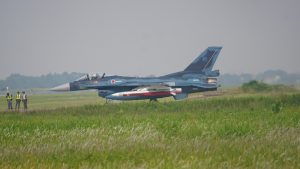Japan has picked its partner for its next generation fighter. As Rieko Miki of Nikkei Asian Review reports, after some throat clearing but not overmuch suspense, the Japanese have decided that they will work with the United States, rather than the United Kingdom. Japan had played coy, projecting indications that it might choose to engage with the Tempest or even the European Future Combat Air System (FCAS) projects, but most analysts believed that the United States had an advantage. President Trump put heavy pressure on Japan to partner with the US rather than the UK. Tokyo also undoubtedly sees the long-term advantages of cementing its partnership with the United States, rather than a United Kingdom of limited geostrategic relevance and reach.
To recap, Japan is looking for a long-range heavy fighter with stealth characteristics that it can use to patrol and protect its vast maritime spaces. The fighter will enter service sometime in the 2030s. Japan has sought to share development costs and technological risks with another country, and among plausible partners the United States has the most experience with advanced fighters. Still, Tokyo held out the possibility that it would collaborate with either the Europeans or the British, in part to generate some leverage with the United States.
This does mean that any exports of Japan’s future fighter will be subject to U.S. veto, but it seems unlikely Japan would have much interest in exporting to countries that the U.S. dislikes in any case. However, the Japanese Minister of Defense did note that negotiating priorities would include right of modification and upgrade, a problem that has proven frustrating with respect to the F-2 fighter fleet. Attention to and sophistication of contracting for rights regarding technology transfer and intellectual property has advanced considerably since the F-2, as countries and firms pay more attention to right of repair and long-term maintenance costs. With this in mind, Miki notes that Japan would prefer to develop the plane’s mission and electronic systems on its own, although it has held out an open hand towards the United Kingdom with respect to these requirements.
Japan’s decision to reject collaboration on the Tempest puts the entire British project in some question. The UK continues (as Japan) to invest in the F-35, both for the Royal Air Force and the Royal Navy. Whether it can persist with a new fighter project on its own, while facing an uncertain budgetary situation, is now unclear. Apart from Russia, the United Kingdom has the smallest economy of any country attempting to develop a sixth generation fighter.

































